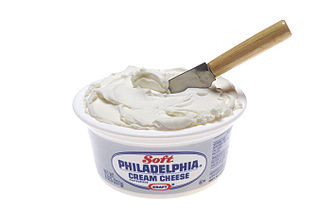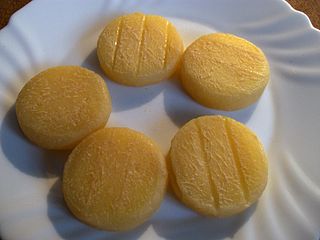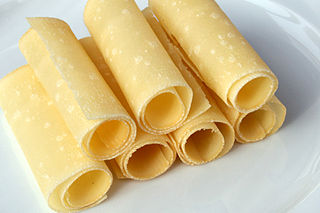
Dairy products or milk products, also known as lacticinia, are food products made from milk. The most common dairy animals are cow, water buffalo, nanny goat, and ewe. Dairy products include common grocery store food around the world such as yogurt, cheese, milk and butter. A facility that produces dairy products is a dairy. Dairy products are consumed worldwide to varying degrees. Some people avoid some or all dairy products because of lactose intolerance, veganism, environmental concerns, other health reasons or beliefs.

Mozzarella is a semi-soft non-aged cheese prepared by the pasta filata ('stretched-curd') method with origins from southern Italy.

Cottage cheese is a curdled milk product with a mild flavour and a creamy, heterogeneous, soupy texture, made from skimmed milk. An essential step in the manufacturing process distinguishing cottage cheese from other fresh cheeses is the addition of a "dressing" to the curd grains, usually cream, which is mainly responsible for the taste of the product. Cottage cheese is not aged.

Parmesan is an Italian hard, granular cheese produced from cow's milk and aged at least 12 months or, outside the European Union and Lisbon Agreement countries, a locally produced imitation.

Goat cheese, goat's cheese or chèvre is cheese made from goat's milk. Goats were among the first animals to be domesticated for producing food. Goat cheese is made around the world with a variety of recipes, giving many different styles of cheeses, from fresh and soft to aged and hard.

Asiago is a cow's milk cheese, first produced in Asiago in Italy, that can assume different textures according to its aging, from smooth for the fresh Asiago to a crumbly texture for the aged cheese. The aged cheese is often grated in salads, soups, pastas, and sauces while the fresh Asiago is sliced to prepare panini or sandwiches; it can also be melted on a variety of dishes and cantaloupe. It is classified as a Swiss-type or Alpine cheese.

Leyden, from Dutch: Leidse kaas, is a semi-hard, cumin and caraway seed flavoured cheese made in the Netherlands from cow's milk. It is made both in factories and on farms, historically in the Leiden area.

Cream cheese is a soft, usually mild-tasting fresh cheese made from milk and cream. Cream cheese is not naturally matured and is meant to be consumed fresh, so it differs from other soft cheeses such as Brie and Neufchâtel. It is more comparable in taste, texture, and production methods to Boursin and mascarpone. Stabilizers such as carob bean gum and carrageenan are often added in industrial production.

Cheez Whiz is a brand of processed cheese sauce and spread produced by Kraft Foods. It was developed by a team led by food scientist Edwin Traisman (1915–2007). It was first sold in 1952, and, with some changes in formulation, continues to be in production today.

Paneer, also known as ponir, is a fresh acid-set cheese common in cuisine of the Indian subcontinent made from full-fat buffalo milk or cow milk. It is a non-aged, non-melting soft cheese made by curdling milk with a fruit- or vegetable-derived acid, such as lemon juice.

Brie de Meaux is a French brie cheese of the Brie region and a designated AOC product since 1980. Its name comes from the town of Meaux in the Brie region. As of 2003, 6,774 tonnes were produced annually.

Olomoucké tvarůžky, also known as olomoucké syrečky or tvargle, English: Olomouc cheese, Olomouc curd cheese) is a ripened soft cheese made in Loštice, Olomouc Region, Czech Republic. The cheese is very easy to recognize by its strong scent, distinctive pungent taste and yellowish colour. It is named after the city of Olomouc where it was originally sold.

Amasi, emasi, maas, or mafi, is a thick curdled sour fermented milk product that is sometimes compared to cottage cheese or plain yogurt but has a much stronger flavor. A staple food in pre-colonial times, it is now a popular snack in South Africa and Lesotho.

Cheese is a type of dairy product produced in a range of flavors, textures, and forms by coagulation of the milk protein casein. It comprises proteins and fat from milk. During production, milk is usually acidified and either the enzymes of rennet or bacterial enzymes with similar activity are added to cause the casein to coagulate. The solid curds are then separated from the liquid whey and pressed into finished cheese. Some cheeses have aromatic molds on the rind, the outer layer, or throughout.

Caprino is an Italian cheese traditionally made from whole or skimmed goat's milk. The name of the cheese derives from the Italian word for goat, capra. With modern methods of production, the cheese is made from cow's milk as well or a combination of both cow's and goat's milks. The two major styles of caprino are fresco ("fresh") and stagionato ("aged").

There are many different types of cheese. Cheeses can be grouped or classified according to criteria such as length of fermentation, texture, methods of production, fat content, animal milk, and country or region of origin. The method most commonly and traditionally used is based on moisture content, which is then further narrowed down by fat content and curing or ripening methods. The criteria may either be used singly or in combination, with no single method being universally used.

Berner Alpkäse is a hard cheese produced in the Alps of the Bernese Oberland and adjacent areas of Switzerland. It is classified as a Swiss-type or Alpine cheese, and is a spicy, full-fat, raw milk cheese without holes. The cheese is manufactured exclusively with manual labour, usually on a wood fire. An extra-hard variety of Berner Alpkäse, known as Berner Hobelkäse, is aged for at least two years and it is this variety that is most widely available. Both Berner Alpkäse and Berner Hobelkäse are certified as AOPs in Switzerland.
Salva cheese from Crema is a PDO table cow's milk cheese made with raw curd. It is a washed-rind cheese that undergoes a medium or long aging period.

















